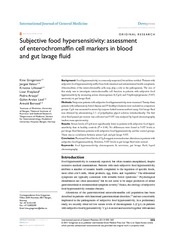Subjective food hypersensitivity: assessment of enterochromaffin cell markers in blood and gut lavage fluid
Gregersen, Kine; Valeur, Jørgen; Lillestøl, Kristine; Frøyland, Livar; Araujo, Pedro; Lied, Gülen Arslan; Berstad, Arnold
Peer reviewed, Journal article
Published version
Permanent lenke
https://hdl.handle.net/1956/6719Utgivelsesdato
2011-08Metadata
Vis full innførselSamlinger
Originalversjon
https://doi.org/10.2147/ijgm.s18349Sammendrag
Background: Food hypersensitivity is commonly suspected, but seldom verified. Patients with subjective food hypersensitivity suffer from both intestinal and extraintestinal health complaints. Abnormalities of the enterochromaffin cells may play a role in the pathogenesis. The aim of this study was to investigate enterochromaffin cell function in patients with subjective food hypersensitivity by measuring serum chromogranin A (CgA) and 5-hydroxytryptamine (5-HT, serotonin) in gut lavage fluid. Methods: Sixty-nine patients with subjective food hypersensitivity were examined. Twenty-three patients with inflammatory bowel disease and 35 healthy volunteers were included as comparison groups. CgA was measured in serum by enzyme-linked immunosorbent assay. Gut lavage fluid was obtained by administering 2 L of polyethylene glycol solution intraduodenally. The first clear fluid passed per rectum was collected and 5-HT was analyzed by liquid chromatography tandem mass spectrometry. Results: Serum levels of CgA were significantly lower in patients with subjective food hypersensitivity than in healthy controls (P 0.04). No differences were found in 5-HT levels in gut lavage fluid between patients with subjective food hypersensitivity and the control groups. There was no correlation between serum CgA and gut lavage 5-HT. Conclusion: Decreased blood levels of CgA suggest neuroendocrine alterations in patients with subjective food hypersensitivity. However, 5-HT levels in gut lavage fluid were normal.

